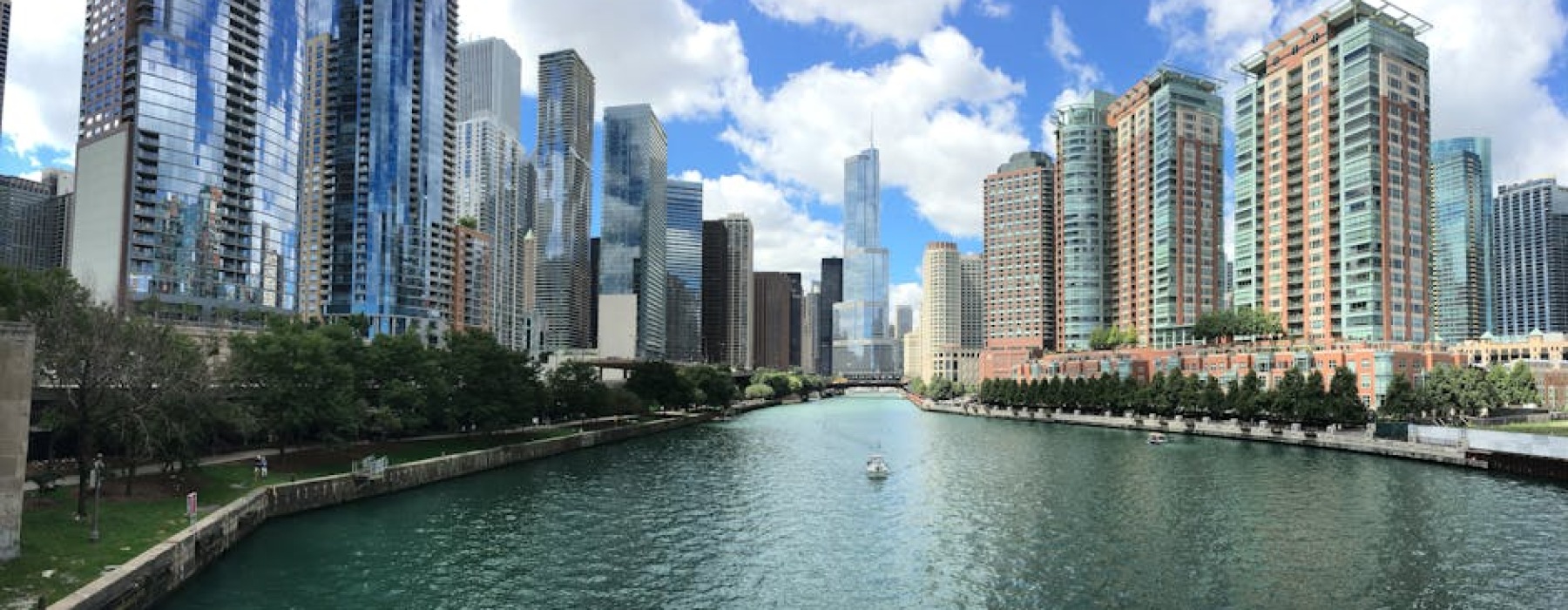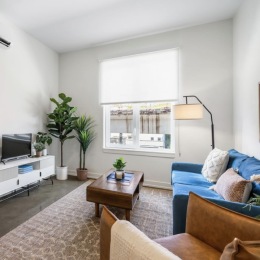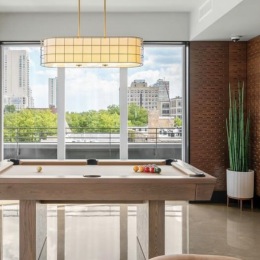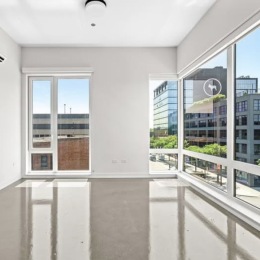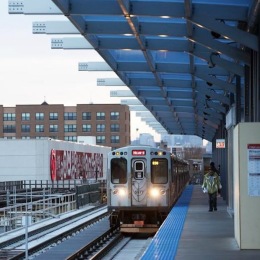Reaching New Heights: The Chicago High-Rise Experience
High-rise living Chicago offers a distinctive urban lifestyle combining breathtaking views, premium amenities, and convenient access to the city's vibrant culture. For those considering this liftd way of life, here's what you need to know:
- Definition: Buildings typically 70+ feet tall or more than 7 stories
- Price Range: From luxury penthouses to more accessible studio options
- Top Neighborhoods: Streeterville, River North, Gold Coast, The Loop
- Key Benefits: Panoramic views, on-site amenities, improved security
- Notable Features: Rooftop pools, fitness centers, in-unit workspaces
Chicago has blazed a trail for high-rise apartment living since the John Hancock Center stretched to 100 stories in 1969. Today, the city's skyline showcases architectural innovation with buildings that combine luxury, convenience, and community.
There's something special about waking up to panoramic views of Lake Michigan or the Chicago skyline. High-rise residents enjoy not just the views but also premium amenities that often include resort-style pools, state-of-the-art fitness centers, and dedicated co-working spaces – creating a lifestyle where convenience meets luxury.
Of the 12 tallest residential buildings in the United States, seven call Chicago home – making the Windy City a premier destination for those seeking an liftd urban experience. Modern high-rises combine the energy of downtown living with the comforts of a luxury retreat, often within walking distance of world-class dining, shopping, and entertainment.
Whether you're a young professional seeking convenience, a family looking for security and amenities, or someone who simply appreciates breathtaking views, Chicago's high-rise options present a compelling lifestyle choice worth exploring.

High-rise living Chicago: Definition & History
When you hear the term High-rise living Chicago, we're talking about those towering residential buildings that reach at least 70-75 feet into the sky or stretch beyond seven stories. These vertical communities have become synonymous with Chicago's iconic skyline, but their story begins well before our modern glass towers.
Chicago's love affair with reaching skyward started in the late 19th century through two game-changing innovations: steel-frame construction and reliable elevator technology. Before these breakthroughs, buildings simply couldn't safely grow beyond a few stories. Once architects could build with steel instead of load-bearing walls, and residents could avoid climbing endless stairs, Chicago's vertical potential was releaseed.
The completion of the John Hancock Center in 1969 marked a watershed moment for High-rise living Chicago. Standing proudly at 100 stories, this architectural marvel proved that people could comfortably live in super-tall structures alongside offices and retail spaces. The mixed-use approach pioneered by the Hancock forever changed how Chicagoans thought about urban living.
Wolf Point holds special significance in this vertical evolution. This spot where the Chicago River's three branches meet once hosted a humble log cabin hotel in the 1830s. Today, it boasts a stunning 60-story residential tower where residents enjoy breathtaking views of the river from all angles. It's hard to imagine a more perfect symbol of Chicago's change from frontier outpost to vertical metropolis.
For a deeper understanding of how zoning laws have shaped this skyward growth, check out the latest research on zoning, which explains how city regulations continue to influence where and how tall our buildings can grow.
High-rise living Chicago vs Low- & Mid-Rise Options
Choosing your perfect Chicago home means understanding what makes each building type unique:
| Feature | High-Rise (7+ stories) | Mid-Rise (4-6 stories) | Low-Rise (1-3 stories) |
|---|---|---|---|
| Views | Panoramic city/lake views | Limited city views | Street-level views |
| Amenities | Extensive (pools, gyms, lounges) | Moderate | Minimal or none |
| Privacy | Higher floors offer more privacy | Moderate | Less privacy in urban areas |
| Elevator Dependency | Complete | Partial | Minimal or none |
| Community Size | Larger (100+ units) | Medium (30-100 units) | Smaller (under 30 units) |
| Security Features | 24/7 staff, cameras, controlled access | Moderate security | Basic locks and entry systems |
| Wind Exposure | Higher (noticeable on upper floors) | Moderate | Minimal |
| Natural Light | Abundant on higher floors | Moderate | Varies by surrounding buildings |
High-rise living Chicago definitely wins the amenities race with rooftop pools and expansive fitness centers, but this comes with trade-offs like longer elevator waits and potentially more neighbors. Mid-rise buildings strike a nice balance between community perks and intimacy, while low-rises often feel more integrated with their neighborhoods and require fewer shared spaces.
Who Thrives in High-rise living Chicago
The beauty of High-rise living Chicago is how it attracts and serves such diverse residents:
Young Professionals fall in love with the time-saving lifestyle. When your morning commute shrinks to a quick elevator ride and a few blocks' walk, those precious extra minutes of sleep become a daily luxury. Add in the networking opportunities that happen naturally in shared spaces like roof decks and fitness centers, and career advancement might be just a friendly conversation away.
Students attending downtown schools find high-rises offer the perfect balance of focus and fun. Study lounges provide quiet space away from roommates, while the security of controlled access buildings gives parents peace of mind. Being able to walk to class instead of battling public transportation during Chicago winters? That's priceless.
Families are increasingly finding that vertical living can be surprisingly kid-friendly. Many newer buildings feature dedicated children's playrooms, and the security of knowing exactly who can access your building provides real comfort. Parents appreciate how package receiving services handle everything from grocery deliveries to birthday presents, making family logistics smoother.
Empty Nesters & Retirees often find high-rise living liberating after years of home maintenance. The lock-and-leave convenience means spontaneous travel becomes hassle-free, while the built-in social opportunities combat isolation. Having elevators rather than stairs becomes increasingly valuable as mobility concerns arise.
Remote Workers have perhaps benefited most from recent high-rise evolutions. Dedicated co-working spaces, private meeting rooms for Zoom calls, and reliable high-speed internet throughout the building mean your home office extends well beyond your actual apartment. The separation between "home" and "work" spaces helps maintain work-life balance without ever leaving the building.
As one resident at a downtown Chicago high-rise put it: "The views sold me, but the community keeps me here. I never expected to know so many neighbors by name in a building with hundreds of units."
Benefits & Drawbacks of Elevating Your Lifestyle

When you choose high-rise living Chicago, you're not just selecting an apartment—you're embracing a lifestyle that comes with its own unique charm and challenges. Let's explore what it really means to live in the clouds.
Panoramic Perks & Luxury Conveniences
Nothing quite compares to sipping your morning coffee while watching the sun paint Lake Michigan in golden hues. These breathtaking views are often the first thing that draws people to high-rise living, and for good reason. Whether you're gazing at the twinkling city lights at night or watching sailboats dot the lake on summer weekends, the visual feast is best at street level.
Beyond the views, modern Chicago high-rises have essentially become vertical resorts. "I keep forgetting I have a gym membership," laughs Maria, who moved to a River North high-rise last year. "Why would I drive somewhere when I have a better facility just an elevator ride away?"
Today's luxury buildings have transformed convenience into an art form. Imagine finishing a work call and stepping directly onto a rooftop pool deck, or letting your dog play in a dedicated run without ever leaving your building. Many residents find that these zero-commute amenities dramatically improve their quality of life.
The security benefits can't be overstated either. With 24/7 door staff, controlled access systems, and comprehensive camera coverage, high-rises offer peace of mind that's hard to find in other housing types. Package delivery services have become increasingly valuable too—no more worrying about boxes sitting unattended on your doorstep.
Perhaps surprisingly, many residents find that high-rise living fosters genuine community. Monthly wine tastings, summer BBQs on the roof, and fitness classes create natural opportunities to meet neighbors. "I've lived in Chicago for ten years," shares James from a South Loop tower, "but I never knew my neighbors until I moved up here. Now we have dinner parties every month."
Considerations & Trade-Offs
Living in the sky does come with its unique challenges. Those spectacular views sometimes come with a side of gentle swaying on windy days. Modern buildings are engineered for this movement—it's completely safe—but it can take some getting used to, especially on higher floors.
Elevator dependence becomes part of daily life. While most luxury buildings maintain their elevators carefully, you'll quickly learn the peak hours when wait times increase. And yes, during rare power outages, you might be taking the stairs—though most premium buildings have backup generators for essential services.
Noise travels differently in high-rises. You might escape street sounds, but find new acoustics—neighbors above, elevator machinery, or hallway conversations. Modern buildings incorporate sophisticated soundproofing techniques, but it's worth investigating during your tour.
Emergency preparedness takes on new dimensions when you live 30 floors up. Familiarizing yourself with stairwell locations and evacuation protocols becomes essential—something many new residents don't consider until their first fire drill.
The financial equation looks different too. Those resort-style amenities and services come with monthly assessment fees that cover everything from the doorman's salary to maintaining the rooftop garden. While these fees provide tremendous value for many residents, they're an important factor in your housing budget.
Pet lovers should pay special attention to building policies. While many Chicago high-rises have become increasingly pet-friendly, offering amenities like washing stations and relief areas, others maintain restrictions on size, breed, or number of pets. If you're moving with furry family members, confirming these details early is crucial.
As Tom, who's lived in high-rises across Chicago for two decades, puts it: "I pay more in monthly fees than I would for a walk-up, but I use the gym daily, work from the co-working space twice a week, and host friends at the pool all summer. For me, the value is undeniable—but everyone needs to do their own math."
Top Neighborhoods & Iconic Towers
The beauty of high-rise living Chicago lies in its diversity across neighborhoods, each offering a unique flavor of vertical living with distinctive character and landmarks that punctuate the famous skyline.
Neighborhood Snapshot: Streeterville & River North
Streeterville captures the essence of premium high-rise living Chicago with its enviable location nestled between Michigan Avenue's shopping paradise and Lake Michigan's shimmering waters. Luxury buildings like The Saint Grand showcase carefully designed units that maximize views and comfort.
What makes Streeterville special? Residents enjoy morning jogs along Ohio Street Beach, weekend strolls to Navy Pier, and the security of living near world-class medical facilities like Northwestern Memorial and Lurie Children's Hospital. The neighborhood perfectly balances urban energy with cultural richness through institutions like the Museum of Contemporary Art right at your doorstep.
Just across the Michigan Avenue Bridge, River North delivers what many consider the perfect urban cocktail – equal parts dining, nightlife, and residential luxury. Modern towers like OneEleven and The Leo represent the neighborhood's forward-thinking approach to vertical living.
"Living in River North means having Chicago's best restaurants as your extended kitchen," shares a resident from a 50th-floor apartment. "I can walk to 30 different cuisines within a 10-minute radius."
The neighborhood boasts Chicago's highest concentration of art galleries and restaurants, while the popular Riverwalk provides a scenic escape from the urban grid. Tech-forward buildings with smart home features complement the area's innovative spirit.
Beyond these hotspots, high-rise living Chicago thrives in several distinctive neighborhoods:
Gold Coast blends historic charm with luxury high-rises, offering proximity to Oak Street Beach and designer boutiques that rival international shopping destinations.
The Loop puts you at the pulsing heart of downtown with convenient access to corporate headquarters, the Theater District, and the beloved green space of Millennium Park.
South Loop continues its rapid growth with new construction, providing easier access to Museum Campus and Soldier Field for sports enthusiasts.
Hyde Park balances academic energy from the University of Chicago with a mix of historic and contemporary high-rise options.
Uptown emerges as an exciting frontier for high-rise development with more attainable price points and excellent lakefront access. Here, The Sally Apartments by Flats® stands out by offering modern luxury with authentic neighborhood character, including pet-friendly amenities that truly understand urban pet owners' needs.
Skyline Legends to Know
Chicago's skyline tells the story of architectural innovation through buildings that have redefined vertical living:
Trump Tower commands attention at 1,389 feet with 96 stories, making it Chicago's tallest residential building. Its luxury residences feature 10-foot ceilings and wall-to-wall windows that frame the city like living artwork.
Vista Tower (St. Regis) showcases architect Jeanne Gang's genius through a 101-story masterpiece with a distinctive wavy façade that seems to dance against the sky, housing some of the city's most exclusive residences.
One Bennett Park brings classic sophistication to the skyline with its 70-story limestone tower designed by Robert A.M. Stern, blending timeless aesthetics with modern luxury.
NEMA Chicago dominates the South Loop skyline at 76 stories, offering over 800 rental units with cutting-edge amenities and integrated smart home technology that anticipates residents' needs.
Aqua remains perhaps Chicago's most visually distinctive high-rise with undulating balconies designed to mimic rippling water. This mixed-use marvel includes both condominiums and apartments within its fluid form.
John Hancock Center (875 N. Michigan) pioneered the mixed-use skyscraper concept in 1969, standing 100 stories tall and setting standards that continue to influence high-rise design today.
Optima Signature lifts Streeterville living with its 57-story presence featuring an astounding 1.5 acres of amenity space spread across four floors and the ultimate urban convenience – direct access to Whole Foods.

"Chicago's high-rises aren't just buildings; they're vertical neighborhoods with their own personalities," reflects a resident who has called three different downtown towers home. "Each one has its own community vibe and lifestyle offering."
The city's iconic towers don't just shape the skyline – they shape the living experience of thousands who wake up to The Magnificent Mile shopping just an elevator ride away from home.
Amenities, Sustainability & Safety Checklist
When exploring high-rise living Chicago options, you'll want to look beyond just the view and square footage. Today's vertical communities offer an impressive array of features that can truly transform your daily life.
Green, Smart, Secure
The best Chicago high-rises have acceptd sustainability without sacrificing luxury. Many newer buildings proudly display their LEED certification, which means they've met rigorous standards for energy efficiency, water conservation, and sustainable materials.
"I was surprised how much my utility bills dropped after moving from my older apartment to a LEED-certified building," shares a resident in Uptown. "The triple-pane windows make a huge difference in both energy costs and street noise."
Smart technology has also revolutionized high-rise living. Imagine adjusting your thermostat while still in bed or getting a notification when your package arrives. These aren't futuristic dreams but everyday realities in modern towers. Many buildings now feature keyless entry systems, allowing you to use your smartphone instead of fumbling for keys.
Security remains a top priority for high-rise developers. Beyond the standard doorman, today's buildings implement sophisticated systems including:
Multiple access control points that prevent unauthorized entry while making access seamless for residents. Comprehensive camera coverage in common areas provides peace of mind, while separate service elevators ensure delivery personnel don't need access to residential floors.
At The Sally Apartments by Flats®, these security features blend seamlessly with sustainability initiatives and smart home technology, creating a living environment that's as convenient as it is responsible.
What to Look for on a Tour
When you're touring potential high-rise homes, be strategic about what you observe. That stunning view might sell you immediately, but remember to check which direction the unit faces. South and east-facing apartments in Chicago often capture those coveted lake views, while west-facing units treat you to spectacular sunsets over the city skyline.
Pay attention to floor plan efficiency too. "My 750-square-foot high-rise apartment feels more spacious than my friend's 900-square-foot garden apartment," notes one downtown resident. "It's all about how the space is designed." Look for thoughtful storage solutions and multi-purpose areas that maximize livability.
Noise levels can make or break your high-rise experience. Visit potential buildings during different times of day—especially during the morning rush and evening hours when most residents are home. Ask specifically about soundproofing between units, as this can vary dramatically between buildings.
If you have a four-legged family member, verify not just that pets are allowed but how genuinely pet-friendly the building is. The Sally Apartments by Flats® sets the standard with dedicated pet amenities including a convenient dog run and pet spa that make vertical living with animals truly enjoyable.
Don't forget to test the elevators! During peak hours, observe wait times and capacity. Buildings with separate service elevators typically offer more reliable resident elevator service. One resident advises, "I always time the elevator wait during my tour visits. It might seem silly, but when you're rushing to work, those extra minutes matter."
Storage options deserve careful consideration too. Even the most beautiful high-rise apartment can feel cramped without adequate storage. Check for both in-unit storage and the availability of additional storage units for seasonal items or hobby equipment.

"When I first toured The Sally Apartments by Flats®," shares a resident, "I was impressed by how the amenities addressed real everyday needs—from the package receiving system to the rooftop terrace perfect for morning coffee. These thoughtful touches make vertical living feel like a true upgrade." Check out more info about building amenities to see how the right features can improve your daily routine.
When scheduling tours, ask about virtual options if you're relocating from out of town. Many buildings now offer detailed digital walkthroughs that can help you narrow your choices before visiting in person.
The best high-rise isn't necessarily the tallest or the newest—it's the one that aligns with your lifestyle priorities while providing the features that make your daily routine smoother and more enjoyable.
Prices, Trends & How to Land Your Unit
The market for high-rise living Chicago offers something for everyone, from cozy studios to breathtaking penthouses with panoramic views. Whether you're looking to rent or buy, understanding today's trends and knowing how to steer the process will give you an edge in this competitive market.
Rent vs Buy Snapshot
Deciding whether to rent or purchase depends on your financial goals, lifestyle, and how long you plan to stay. Here's a practical comparison to help you weigh your options:
| Factor | Renting | Buying |
|---|---|---|
| Initial Costs | Security deposit, first/last month | Down payment (typically 20%), closing costs |
| Monthly Expenses | Rent, possibly utilities | Mortgage, property taxes, HOA fees, insurance |
| Maintenance Responsibility | Minimal (building handles most) | Responsible for in-unit repairs |
| Flexibility | Can move when lease ends | Requires selling or renting out |
| Building Amenities | Full access, included in rent | Full access, paid via HOA fees |
| Tax Benefits | None | Potential mortgage interest deduction |
| Appreciation Potential | None | Property may increase in value |
"I rented in three different high-rises before finding the building I wanted to buy in," shares a Gold Coast condo owner. "Renting gave me the chance to experience different neighborhoods and building styles before committing to a purchase."
The pandemic has reshaped what buyers and renters prioritize in high-rise living Chicago. Home offices are no longer a luxury but a necessity, with many seeking units offering dedicated workspace. Outdoor spaces have become premium features, whether it's a private balcony or a building's rooftop deck. Buildings with thoughtful package management systems have gained popularity as online shopping continues to grow. Pet-friendly buildings with amenities like dog runs and pet spas (like those at The Sally Apartments) have seen increased demand as pet ownership soared during lockdowns.
Step-by-Step to Secure a Lease or Purchase
Finding your perfect high-rise home takes planning and preparation. Here's your roadmap to success:
1. Establish Your Budget and Must-Haves Before falling in love with a view you can't afford, be realistic about your finances. For rentals, the standard advice is to spend no more than 30% of your income on housing. If you're buying, get pre-approved for a mortgage to understand your true price range. Make two simple lists: your non-negotiables (like in-unit laundry or pet-friendly policies) and your wish-list items (like a rooftop pool or fitness center).
2. Research Neighborhoods and Buildings Each Chicago neighborhood has its own personality. Visit potential areas at different times—a quiet Sunday morning might feel very different from a Friday night. Read building reviews online and, whenever possible, chat with current residents about their experiences. Ask specific questions about elevator wait times, noise levels, and management responsiveness.
3. Schedule Strategic Tours Plan to see 2-3 buildings in the same area on a single day for easier comparison. Ask to view different unit layouts if available—a well-designed studio might work better for you than a poorly laid-out one-bedroom. Don't rush through amenity spaces; sit on that rooftop deck for a few minutes and imagine your morning coffee there.
4. Ask the Right Questions For rentals, clarify what's included in your rent. Are utilities separate? What's the typical rent increase at renewal? Are there restrictions on decorating? For purchases, understand the full financial picture: monthly HOA fees, upcoming special assessments, and the percentage of owner-occupied units (which can affect financing options).
5. Prepare Your Application In competitive buildings, being prepared can make the difference. Have financial documents ready (pay stubs, bank statements, tax returns), secure references from previous landlords, and be prepared for credit and background checks. Having everything organized shows property managers you'll be an equally organized tenant.
6. Act Quickly on the Right Unit When you find a unit that checks your boxes, don't hesitate. Desirable units in popular buildings often receive multiple applications the same day they're shown. For purchases, work with an agent who specializes in high-rise properties and understands the nuances of condo documents and HOA regulations.
At The Sally Apartments by Flats®, we understand that finding your perfect high-rise home can feel overwhelming. Our leasing specialists guide you through each step with transparency and warmth, making your transition to high-rise living Chicago as smooth as possible. We believe everyone deserves a straightforward path to their dream home in the sky.
Frequently Asked Questions about High-rise living Chicago
Are Chicago high-rises pet-friendly and what amenities exist?
The days when pet owners struggled to find welcoming high-rise homes are largely behind us. Most modern high-rise living Chicago buildings now accept four-legged residents, though with varying degrees of enthusiasm and accommodation.
"When I was apartment hunting, finding a truly pet-friendly building was my top priority," shares Maria, a resident with two dogs. "Not just one that allowed pets on paper, but one that actually welcomed them with thoughtful amenities."
At The Sally Apartments by Flats®, we've created a genuinely pet-friendly community with features that pet parents love:
- A climate-controlled indoor dog run where pups can play regardless of Chicago's unpredictable weather
- A dedicated pet spa with professional-grade washing stations for post-park cleanups
- Convenient relief areas on multiple floors (because waiting for the elevator during urgent bathroom breaks is no fun)
- Regular pet social events where residents and their furry friends can build community
Typical pet policies across Chicago high-rises include weight limits (usually 40-50 pounds, though many newer buildings have no restrictions), breed considerations, pet deposits, and monthly pet rent. Most buildings cap the number of pets at two per apartment, though some luxury buildings are more flexible.
Some Chicago high-rises have truly raised the bar—Heritage at Millennium Park features astro-turf dog runs complete with fire hydrants, while others offer partnerships with local pet walkers, groomers, and veterinarians for true pet-centric living.
How do security features in high-rises compare to other housing types?
When it comes to security, high-rise living Chicago typically offers advantages that single-family homes and smaller buildings simply can't match.
Most high-rises implement multiple security layers, starting with controlled entry points where visitors must be announced and cleared before accessing residential floors. Many luxury buildings maintain round-the-clock door staff who not only monitor entrances but also become familiar with residents, quickly identifying anyone who doesn't belong.
"I actually feel safer here than I ever did in my house," explains Tom, who recently traded his single-family home for a downtown high-rise. "Between the doorman who knows me by name, the secure entry system, and knowing there are always people around, there's a constant sense of security I never experienced before."
High-end buildings often feature comprehensive camera systems covering common areas, entrances, and elevators. Many newer developments use separate elevator banks for different floor ranges, effectively creating smaller, more secure communities within the larger building.
Emergency preparedness also gets special attention in high-rises, with advanced fire detection systems, sprinklers, and evacuation procedures specifically designed for vertical communities. Many buildings conduct regular safety drills to ensure residents know exactly what to do in rare emergency situations.
What sustainability trends are emerging in new Chicago towers?
Chicago has established itself as a leader in sustainable vertical development, with developers increasingly viewing green features not as optional upgrades but as essential components of modern building design.
Energy efficiency stands at the forefront of sustainable high-rise design, with new buildings incorporating high-performance windows, advanced insulation, and smart HVAC systems that significantly reduce consumption while improving resident comfort. Many buildings now feature smart home technology that automatically adjusts lighting, heating, and cooling based on occupancy patterns.
Water conservation efforts include low-flow fixtures, rainwater collection systems for landscaping, and drought-resistant plants that thrive with minimal irrigation. Some forward-thinking developments are even implementing greywater recycling systems that reuse water from sinks and showers for toilet flushing.
"Living in a LEED-certified building wasn't initially on my priority list," admits Jennifer, a resident of a sustainable Chicago high-rise, "but I've come to appreciate the better air quality, consistent temperature control, and lower utility bills—not to mention knowing my home has a smaller environmental footprint."
Chicago's famous green roofs have become increasingly common in residential high-rises, helping manage stormwater, reduce the urban heat island effect, and provide beautiful outdoor spaces for residents. Many buildings are also embracing transit-oriented development, strategically locating near public transportation hubs to reduce car dependency.
The Sally Apartments by Flats® incorporates many of these sustainable approaches, reflecting our commitment to responsible development while providing residents with the benefits of energy-efficient, healthy living spaces that are kind to both the environment and your utility bills.
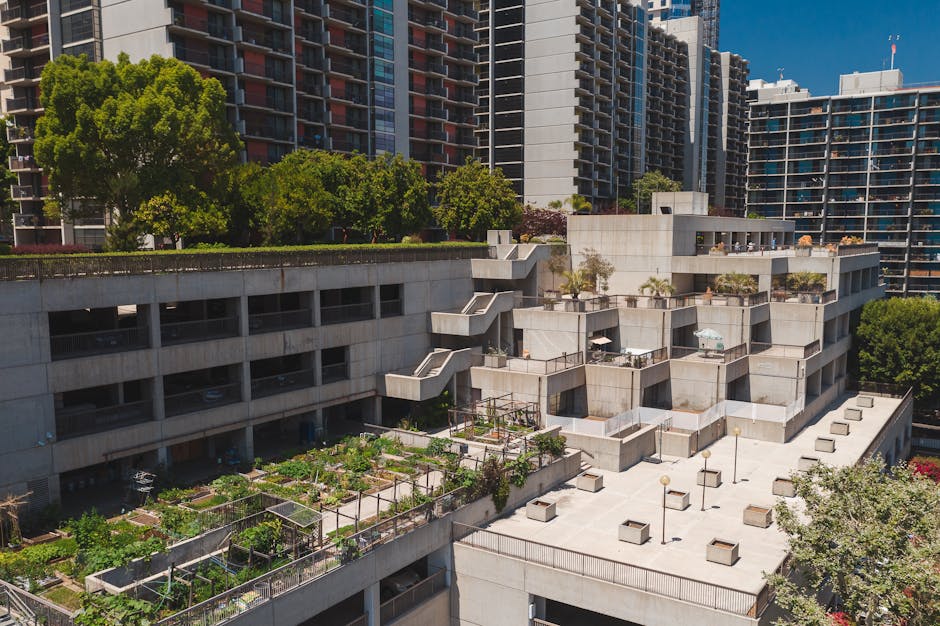
Conclusion
High-rise living Chicago offers a captivating blend of luxury, convenience, and community that continues to draw residents from all walks of life. While the breathtaking views certainly stand as a highlight—watching the sun set over the city skyline or seeing Lake Michigan stretch to the horizon—the lifestyle benefits extend far beyond what you can see through your windows.
Think about rolling out of bed and heading straight to a professional-grade gym without leaving your building. Or hosting friends for a rooftop gathering with the city lights twinkling below. These everyday luxuries transform ordinary routines into something special, giving you more time to enjoy Chicago rather than maintaining a property or commuting to amenities.
Chicago's high-rise landscape has evolved thoughtfully over the decades. Newer developments now emphasize sustainability features, create genuinely welcoming spaces for pets, and incorporate dedicated areas for remote work—innovations that keep vertical living relevant in our changing world.
The city that pioneered modern skyscrapers continues to perfect the art of vertical living. Whether you're drawn to historic buildings with character and modern updates or sleek contemporary towers with cutting-edge technology, Chicago offers high-rise options to match virtually any lifestyle preference and need.
At The Sally Apartments by Flats® in Uptown, we've created a community that captures the essence of liftd Chicago living while maintaining a neighborhood feel. Our rooftop terrace provides the panoramic views you crave, while modern finishes blend comfort with style. Pet parents particularly appreciate our thoughtful amenities, including our dedicated dog run that makes high-rise living convenient for four-legged family members.
Living in a Chicago high-rise isn't just about having a place to sleep—it's about experiencing the city from a perspective few get to enjoy. It's about community, convenience, and the small luxuries that make everyday life more enjoyable.
Your journey to a fresh perspective on urban living awaits—just an elevator ride away.
